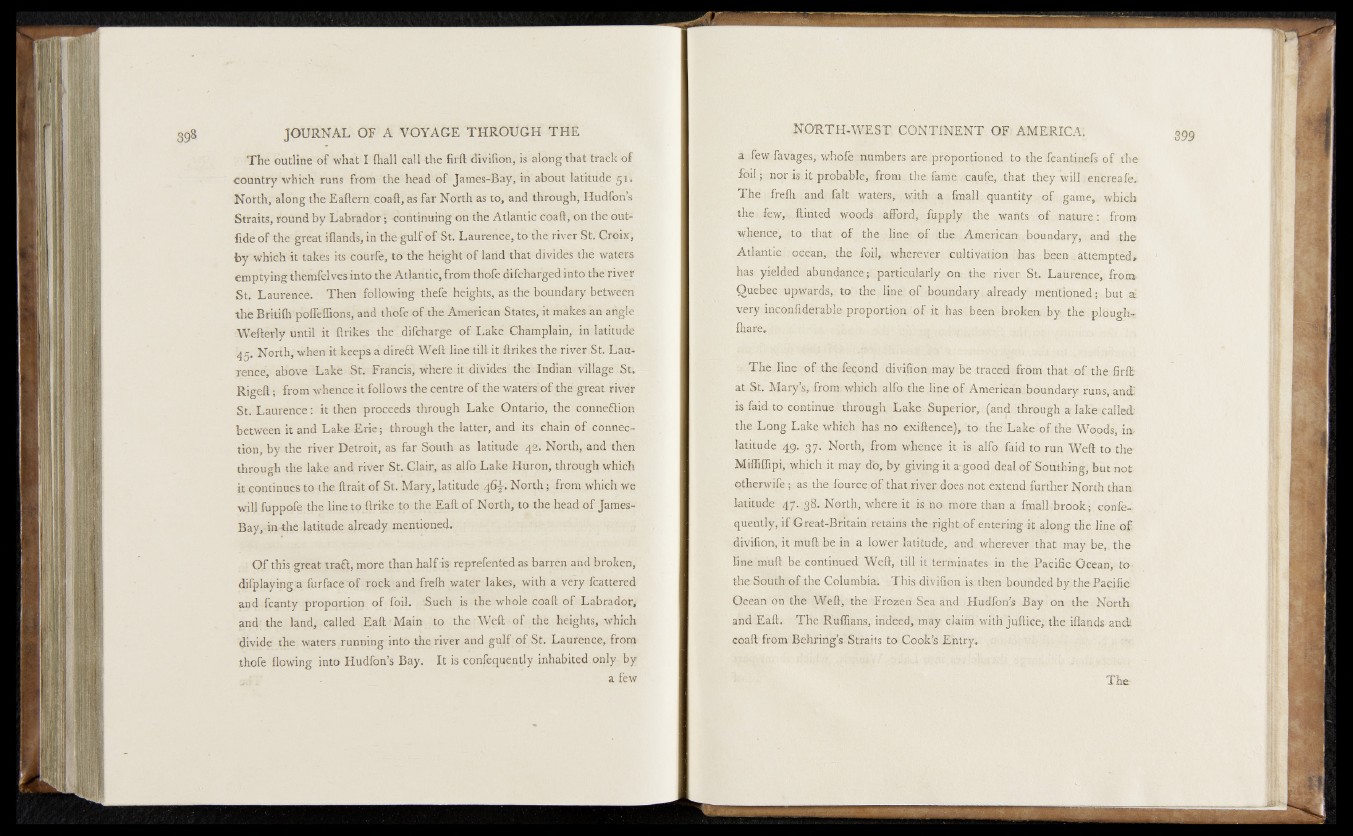
, The outline öf what I fhall ê&lMhe ftfft di^ifion, istsdbng'that tradk of
country which runs from the head o f : James-Bay, iti about latkiide gï»
North, along the Eaftern. coaft, as far North as th; and through, Hudfeh’s
Straits, round by Labrador; -continuing on-the Atlantic c-oaft, -on- the out*
fide of the great iflands, in thégü lfo f St. Laurence, to'thé river Sfc.'Cföix,
by which it takes its courfe/tó' the height o f land that divides thé waters
emptying theinfelves into the Atlantic, from thofe difeharged into the rivef
St; Laurence. Then following thefe heights, as the bounda&ybetwddn.
the BritifliJpolfelfions, and .
Wefterly until it ftrikes the'jdifcharge of Lake Champlain, indatitud©
^yiMoiih; whenritdceeps idirefll rWeft line till it ftrikes the.rivèriSt.*Lau-
jenfcO, above "Lake St. Francis^ where it'diHdss'lhe, Indian sV'fllag.elSt;
Rigeft; from whence it follows the centre ofSthe watêïsiof ;§hehgreat rivdf
St. Laurence: it then proceeds through Lake Ontario, the connexion
between it and Lake E rie; through the latter, and its chain of connect
tion, by the river Detroit, as far South as latitude.' 42. Northland-then
through the l^ce and river St.-Clair, as alfo Lake Huron, through which
k eontinUes tO/the ftrait of St. Mary, lptitude»4fi£: Norths ~from-.w!hich'we
will fuppofe the line to ftrike to the Eaft o f North,’ to the head o f James-
Bay,5in-the latitude already mentioned.
O f this great traft, more than half i f reprefented as barren and broken,
difplayinga furface 'of Tock/and frelh water lakes, with a very fcattered
apd^fcanty proportion o f foil. r Such is the whole coaft ofhLpbradoft
and- the land, called Eaft/Main to the-Weft < o f ,the heights, which
divide the vsaters:runmng'into-the river and guff of St. Laurence, from
thofe flowing into Hudfon’s Bay. It is confeguently inhabited .only-by
a few
a few favages, whofeenumbers are .proportioned to,the fcantinefs of the-
foft;^nQrisi|tipr,obablep;from. the, farrie ,/capfe, hhat theyvkilitencreafei
The frelh. and: fait waters, .with ,a .final!, quantity,.of;game, which'
thes few,^ftinted woods, afford fuppl^rihe .w a te v o f nature: from«
whence^ to thatVaf the line’ of .the ,. American ^bpuqdary,, and the
Atlantic,.ocean, the .foil* wherever cultivation ihas been .attempted»
has yielded ‘.abundance ^particularly.,00 the . river- St. Laurence, from.
Quebec up^i&sels* tp,>the3.flnet,©f, sb^da.ty^alr^dy'./meBflQoed^, but m
very• inconfiderable. proportion of it has . been broken by- the plough-
| fliare* -.
$ The.line .of 'the.-fecond divrfton;maybe .traced;from that•,©£■ ,the firlfi
atiSfe Mary’s, from, which alfo-.the .line ofiAmericahiboundary -runs, and
is faid to .continue through,. Lake Superior, (and through a lakhealledi
the . Long Lake-which has no exiftence), Itai,thd,L-ake!offthu. Woods, in
latitude ’49: 37:' North; from g^unee it is alfo Laid to^ run Weft to, the
Miffiffipi, which it* may dec,, b y giving it aigOodc%aLcf.Southing, butbofc
cjtherwife; as.thei.iour.ee,o€ thathivendoesitfofe.&kfe^nd-fwnhpr N^rth than-
latitude 47..;ga.;N0rth^ wbere.it is no morse than a ftnaiUbrook -confe-
quentl.y,if Great-Britain!retains.the righhof entering the Jipe o£
•divifion.,dt mulkbein a lower latitude, and. wherevehjthat-,may be„ the
line m u l be. continued Weft» , till it terminates in ,the,;Pacific.X3 eean3- to?
the South of the Columbia; This di.vifibn.is, then bounded by.,the Pacific.
Ocean on the Weft, thebFrozeniSea,-and Hudfon’s Bay: on the North,
and-Eaft. The Ruffians, indeed,“may claim with juftice, the iflands and
coaft from Behring’s Straits to* Cook Is Entry;